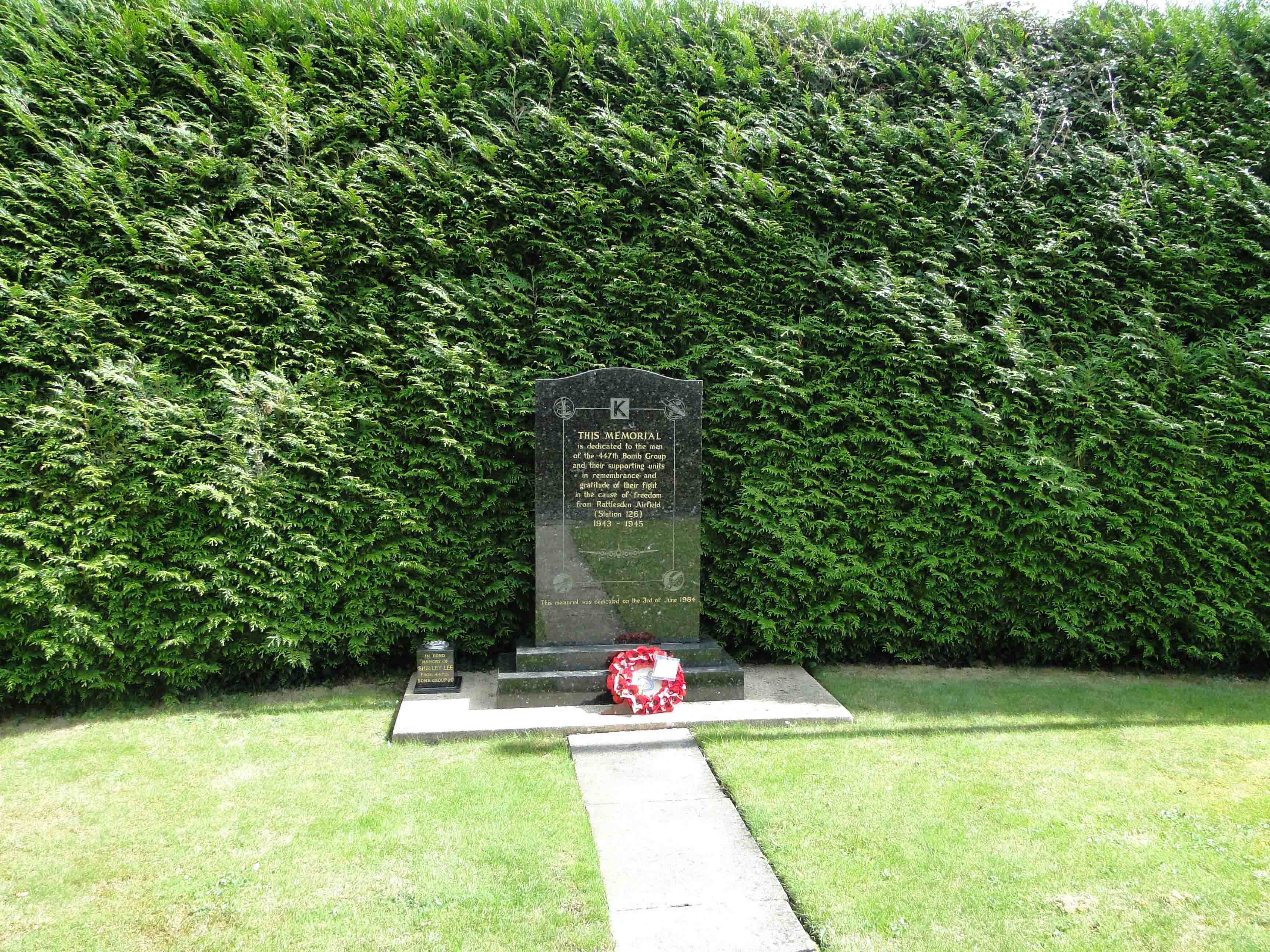447th Bomb Group Memorial
Details:
On the east side of the road.
A rectangular, black, marble stone tablet on a two-step base dedicated to the 447th Bomb and supporting units based at Rattlesden Airfield. The tablet is inscribed in English in gold lettering. Engraved below the commemoration message is a depiction of a B-17 aircraft. Around the commemoration message border are the engraved depiction of the group tail code “Square-K” and the 708th, 709th, 710th, 711th Bombardment Squadron insignias.
Rattlesden airfield was built in 1942 as a Class A bomber airfield. The airfield had three intersecting concrete runways, perimeter track, and, for USAAF use, hardstands for fifty aircraft and two dispersed, black-painted T-2 hangars. Living and messing sites were on the east side of the field. Situated four miles south of the A14 highway between Stowmarket and Bury St. Edmunds
The airfield was opened in 1942 and was used by the United States Army Air Forces Eighth Air Force. Rattlesden was given the USAAF designation Station 126 (RS).
In June 1943, it was decided that the B-26 groups would be better placed to conduct operations from airfields further south. and exchange of bases with the B-17-equipped 4th Bombardment Wing in Essex was arranged. Rattlesden, however, remained without a combat unit until the 447th Bombardment Group (Heavy) arrived from Harvard AAF Nebraska on 29 November 1943. The 447th was assigned a group tail code was a "Square-K". Its operational squadrons were:
- 708th Bombardment Squadron (CQ)
- 709th Bombardment Squadron (IE)
- 710th Bombardment Squadron (IJ)
- 711th Bombardment Squadron (IR)
The group flew the Boeing B-17 Flying Fortress as part of the Eighth Air Force's strategic bombing campaign and served chiefly as a strategic bombardment organization. The 447th's first mission from Rattlesden was despatched on Christmas Eve and, during the course of hostilities, another 256 missions were flown from the base.
The group helped to prepare for the invasion of the Continent by attacking submarine pens, naval installations, and cities in Germany; ports and missile sites in France, and airfields and marshaling yards in France, Belgium, and Germany. During Big Week, 20–25 February 1944, the 447th took part in the intensive campaign of heavy bombers against the German aircraft industry. Supported the invasion of Normandy in June 1944 by bombing airfields and other targets near the beachhead. Aided the breakthrough at Saint-Lô in July and the effort to take Brest in September. Pounded enemy positions to assist the airborne invasion of the Netherlands in September. Also dropped supplies to Free French Forces during the summer of 1944.
The 447th turned to strategic targets in Germany in October 1944, emphasizing sources of oil production until mid-December. 2nd Lt Robert Edward Femoyer, Navigator, won the Medal of Honor for action on 2 November 1944. While on a mission over Germany, his B-17 was damaged by flak, and Femoyer was severely wounded by shell fragments. Determined to navigate the plane out of danger and save the crew, he refused a sedative and, for more than two hours, directed the navigation of the bomber so effectively that it returned to base without further damage. Femoyer died shortly after being removed from the plane.
During the Battle of the Bulge, December 1944-January 1945, the group assaulted marshaling yards, railroad bridges, and communications centers in the combat zone. Then resumed operations against targets in Germany, attacking oil, transportation, communications, and other objectives until the war ended. During this period, also supported the airborne assault across the Rhine in March.
The group returned to Drew AAF Florida in August 1945, its personnel relieved from active duty and aircraft sent to storage. At Drew AAF the 447th was redesignated as the "447th Bombardment Group (Very Heavy)" and allocated to Strategic Air Command w/o/p/e as a reserve unit.
After the war, the field was transferred to the RAF on 10 October 1945. For a short while, it was used by the RAF for basic training (square bashing) and then as a Ministry of Food buffer depot but was finally inactivated on 15 August 1946. In the 1960s part of the site was used for RAF Bristol Bloodhound surface to air missiles but when this was abandoned the whole airfield was sold during 1967/68.
Source of information: www.warmemorialsonline.org.uk, Imperial War Museum War Memorials Register, en.wikipedia.org
Source of photos: www.warmemorialsonline.org.uk
Monument Text:
THIS MEMORIAL
is dedicated to the men
of the 447th Bomb Group
and their supporting units
in remembrance and
gratitude of their fight
in the cause of freedom
from Rattlesden Airfield
(Station 126)
1943-1945
This memorial was dedicated on the 3rd of June 1984



